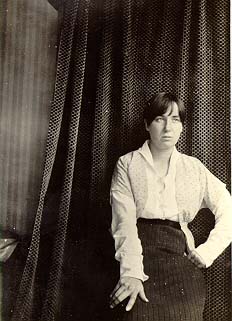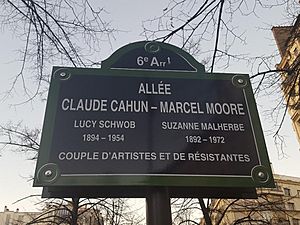Marcel Moore facts for kids
Quick facts for kids
Marcel Moore
|
|
|---|---|

Moore by Claude Cahun
|
|
| Born |
Suzanne Alberte Malherbe
19 July 1892 Nantes, France
|
| Died | 19 February 1972 (aged 79) |
| Resting place | St Brelade's Church |
| Known for | Illustrator, designer, and photographer |
| Movement | Surrealism |
Marcel Moore (born Suzanne Alberte Malherbe, 19 July 1892 – 19 February 1972) was a talented French artist. She was an illustrator, a designer, and a photographer. She is best known for her close artistic partnership with Claude Cahun. Together, they were part of the Surrealism art movement.
Contents
Early Life and Partnership
Marcel Moore was born Suzanne Alberte Malherbe in Nantes, France, on 19 July 1892. She studied art at the Fine Arts Academy in Nantes. In 1909, when she was 17, she met Lucy Schwob, who was 15. They started a lifelong artistic journey together.
Later, in 1917, Suzanne's widowed mother married Lucy's divorced father. This made them stepsisters. This family connection helped them work together creatively and grow their close bond. From 1920 to 1937, they lived in Paris. There, they became involved with the Surrealism art movement. They also took part in exciting new theater projects.
To express themselves freely, they both chose male pseudonyms. Suzanne Malherbe became Marcel Moore, and Lucy Schwob became Claude Cahun. They remained close partners until Claude Cahun's death in 1954.
Artistic Career
When Marcel Moore was in her early twenties, she worked as a graphic designer. She created beautiful illustrations. These designs were inspired by a style called japonism, which used Japanese art ideas. They also showed the latest Paris fashion trends of the 1910s. Her modern fashion drawings were even published in a newspaper called Phare de la Loire.
Moore also worked with the poet Marc-Adolphe Guégan. She drew pictures for two of his books: L'Invitation à la fête primitive (1921) and Oya-Insula ou l'Enfant à la conque (1923).
Marcel Moore is most famous for working with Claude Cahun. For many years, Cahun's photography was not well-known. But in the 1980s, her work was rediscovered. People saw it as an early example of artists like Cindy Sherman creating staged self-portraits.
However, new studies show that Moore was more than just a model for Cahun. She actively helped create some of Cahun's most famous photographs. In fact, some experts believe that Cahun's "self-portraits" were often collaborations with Moore. Sometimes, they would photograph each other posing in the same scene. You can even see Moore's shadow in some pictures of Cahun. This shows her important role behind the camera.
Moore also illustrated Cahun's writing. For Cahun's 1919 poetry book Vues et visions, Moore drew detailed pen-and-ink pictures. These drawings were similar to the decorative style of Aubrey Beardsley. Cahun even dedicated the book to Moore, saying her designs would "redeem" her own writing. In 1930, they published another book together called Aveux non avenus. Moore's illustrations for this book were collages made from her many photographs of Cahun. These collages explored themes of identity, just like Cahun's own photos and poems.
Resistance During World War II
In 1937, Moore and Cahun moved from Paris to Jersey. They likely did this to escape the growing political problems and dangers leading up to World War II. They stayed on the island of Jersey even when German troops invaded in 1940.
For several years, they bravely risked their lives. They created and shared anti-Nazi messages with German soldiers. Moore was fluent in German. This allowed her to translate secret notes and messages that she and Cahun wrote. They hoped to trick the German soldiers into thinking there was a secret resistance group on the island. Moore often took the biggest risks. She would slip her notes into soldiers' pockets or leave them in German staff cars.
As historian Jeffrey H. Jackson explains, fighting the German occupation was a natural step for them. They had always challenged rules and lived life their own way. For them, fighting for freedom was deeply personal.
Their resistance activities were discovered in 1944. They were sentenced to death and put in prison. Luckily, they were saved by the Liberation of Jersey in 1945. However, their home and belongings had been taken, and much of their art was destroyed by the Germans.
Later Life
Claude Cahun's health suffered during her time in prison. She passed away in 1954. After Cahun's death, Moore moved to a smaller home. She was buried next to her partner, Claude Cahun, at St Brelade's Church in Jersey.
Legacy
In 2018, a street in Paris was named "Allée Claude Cahun - Marcel Moore." It is located near the street where Marcel and Claude used to live. This honors their important contributions to art and their brave actions during the war.
See also
 In Spanish: Marcel Moore para niños
In Spanish: Marcel Moore para niños


